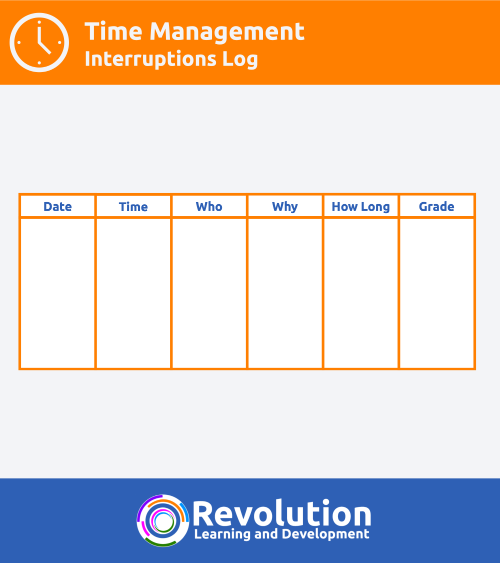Background
Creating an interruptions log. One thing that gets in the way of us being able to get things done is interruptions. They prevent our ability to manage our time effectively as they take us away from the task that we are currently working on. Some interruptions are necessary. Others steal your time and prevent you from working on more important tasks.
Interruptions can come from multiple places – people approaching your desk, a phone call or email, they all prevent us from managing our time and getting things done.
To help reduce the number of interruptions you get, you first need to understand where they come from. This is where creating an interruptions log can help.
Why Create an Interruptions Log?
Interruptions can be frustrating. We waste a lot of time dealing with them but, they can also be preventable. We just need to understand where our interruptions come from and who are the main culprits.
Interruptions can take up more time than we think. It isn’t just the time dealing with the interruption that we lose. We also have to take into account the time it takes to find out what the interrupter wants and how important it is, and the time it takes to get back up to speed with the task that we were working on prior to the interruption.
This is where an interruptions log can help.
What is an Interruptions Log?
An interruptions log is a tool to find out who your persistent offenders are and what are the main reasons you get interrupted for. It’s completed over the space of several days and the idea is that you capture in a log everything that you get interrupted. You can then analyse the data that you have collected to work out who is interrupting you the most, what are the main reasons you get interrupted for and how much time you spend dealing with interruptions.
The log requires a simple template for you to capture this information.
How to Create an Interruptions Log
Create a template with the following headings:
Date, time, who, why and grade. It might look something like this:

Each time you get interrupted (meaning each time you have to stop a task and deal with someone else) fill in the log. Here is how to fill it in:
- Date – capture the date the interruption happened (you just need to capture this once at the start of the day)
- Time – capture each time you get interrupted
- Who – capture the name of the person that interrupted you (you could capture how i.e. walk-up, phone, email etc.)
- Why – what did they interrupt you about
- How long – how long did the interruption take to deal with
- Grade – give the interruption a grade the interruption that shows its importance. For example, if the interruption was very necessary, then grade it an A. If the interruption was completely irrelevant, then grade it as D. Mark other interruptions in between.
Complete your log for around 5-7 days then analyse the data. Look for trends and also look at how much time you have spent dealing with interruptions.
Analysing the Interruptions Log Data
After you have 5-7 days worth of data begin to analyse it. Here are some examples of the types of things to look out for:
- Do you find that you are being interrupted by the same person? If so, it could mean that this person has become reliant on you for information. It also can mean that you are making it too easy for them to ask you. Try asking what they think they should/could do. You could also spend a little more time to make sure they understand how to do the things they are asking for themselves.
- Do you find that different people are interrupting you for the same reason? This suggests a need exists that needs to be addressed, or that you hold some information that others need to do their job. You could make this information more available to reduce interruptions.
- What times of day do you get interrupted the most? Do you get interrupted more in the afternoon than you do in the morning or vice-versa? This could mean that people have less energy at those times and find it easier to ask you questions. It could also mean that you lack energy around those times, and you find it easier to just answer peoples questions.
When you complete your analysis, take action to reduce or remove as many interruptions as you can. This will help to get you that time back and allow you to get on with your more important tasks.
If you wish to find out more about creating and using an interruptions log and other practical tools to help with your own time management then you may find a time management training course will help. Take a look at our Time Management Training Course for more details.




